Arctic Van Test 2016
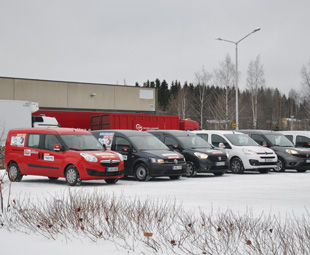
Celebrating its 30th anniversary, the highly respected week-long Arctic Van Test was once again held around Helsinki and in northern Finland during the first two weeks of February.
Six light commercial vehicles took part in what proved to be one of the warmest events on record. They were the Citroën Berlingo, Dacia Dokker, Fiat Professional Doblo Cargo, Opel Combo, Renault Kangoo and Volkswagen Caddy. The Ford Transit Connect was also supposed to take part, but, unfortunately, the test vehicle was in an accident just before the appointed date and Ford didn’t have time to replace it.
While the Citroën Berlingo and Volkswagen Caddy were equipped with the latest Euro-6 engines, the rest had Euro 5s. The most powerful engine was the 1,6-litre MultiJet II in the Fiat Doblo with its 77 kW (105 hp), while the Caddy’s 2,0-litre TDI engine had 75 kW (100 hp).
The Citroën Berlingo used its 1,6-litre HDi engine with 73 kW (98 hp), while both the Kangoo and Dokker were powered by the Renault Group’s 1,5-litre dCi engines; offering 67 kW (90 hp). The engine with the lowest capacity was the Combo’s 1,3-litre CDTi with 66 kW (88 hp).
Every vehicle had front-wheel drive traction and all had five-speed manual gearboxes, with the exception of the Doblo, which had a six-speed unit.
Slippery conditions
Each vehicle had 250 kg of cargo on board and was equipped with Nokian Hakkapeliitta studless winter tyres and fuelled with renewed Neste Oil Pro Diesel during the whole test. For the first part of the test, held in Helsinki and surrounding areas, different measurements were made and the initial sections of the urban drives were held.
In northern Finland, additional urban tests were undertaken in Oulu, with the open-road sections moving from Oulu via Arctic Circle to Iso-Syöte, followed by handling tests at Pudasjärvi airport. The early morning cold-start tests were recorded at Iso-Syöte.
This year was unusually warm with winter temperatures close to 0°C – not particularly Arctic! As for the road conditions, these were extremely slippery.
The abilities of both the drivers and vans were pushed to their limits – especially on the minor roads and during the handling tests, which were, literally, on a sheet of ice. Impressively, the vehicles functioned well on these extremely slippery conditions and the traction provided by studless tyres amazed the international trade press taking part.
Citroën Berlingo Van 1.6 BlueHDi 100 L2 Pro
Agility in the city
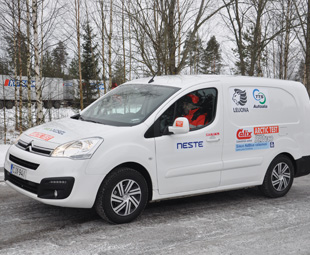 The Citroën Berlingo’s Euro-6 engine worked well in the urban areas and got positive remarks for its silence and pleasant drive. When driving in the city, the latest Berlingo’s start-stop system worked very efficiently and the good functionality of the suspension added to the overall appeal of the driving experience.
The Citroën Berlingo’s Euro-6 engine worked well in the urban areas and got positive remarks for its silence and pleasant drive. When driving in the city, the latest Berlingo’s start-stop system worked very efficiently and the good functionality of the suspension added to the overall appeal of the driving experience.
Visibility from the cabin was noted as good, especially when reversing. The Berlingo and the Kangoo were the only test vehicles that had three seats in the cabin.
The Berlingo has an opening hatch in a dividing wall that allows longer objects to be put in the cargo space. However, the bulging dividing wall reduces a bit of the usage of the vehicle’s side door.
Negative comments were received about gear shifting while driving and the ergonomics inside the cabin. According the test drivers, the Berlingo didn’t perform that well in the category of handling on the minor roads and in the dedicated handling test.
Test points 178
+ Visibility
+ Engine
+ Suspension
– Handling
– Ergonomics
– Cargo space
Fiat Doblo 1.6 Multijet II L1
High-performance
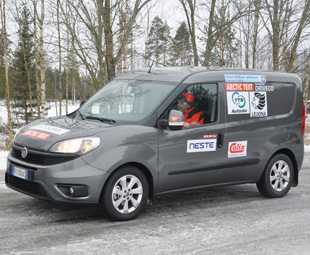 Having the most powerful engine in the Arctic Test 2016 was not enough for the Fiat Doblo to finish ahead of the least-powerful Opel Combo. The Doblo gained best marks for its performance and it also got the laurels in the acceleration comparison. The drivers liked Fiat’s suspension. Noted, too, was that the Doblo Cargo was the only vehicle in the test with a six-speed gearbox.
Having the most powerful engine in the Arctic Test 2016 was not enough for the Fiat Doblo to finish ahead of the least-powerful Opel Combo. The Doblo gained best marks for its performance and it also got the laurels in the acceleration comparison. The drivers liked Fiat’s suspension. Noted, too, was that the Doblo Cargo was the only vehicle in the test with a six-speed gearbox.
Like the Opel, the Doblo has the largest two-piece, side-mirror set-up in the test, but the A-pillar disrupts the view. An armrest between the seats enhances comfort when driving long distances. Fiat’s Traction+ feature adds extra grip when driving on slippery conditions, but only works when the speed is under 50 km/h.
While the Doblo’s engine was the most powerful, it had the poorest performance in the fuel-economy tests. The vehicle tested had tyres that were 10 mm wider than recommended by the factory, which might have something to do with its overall fuel-economy performance.
Test points 183
+ Acceleration
+ Mirrors
+ Suspension
– Visibility
– Heater controls
– Fuel economy
Dacia Dokker Van 1.5 dCi 90 Ambiance
Most cost-efficient
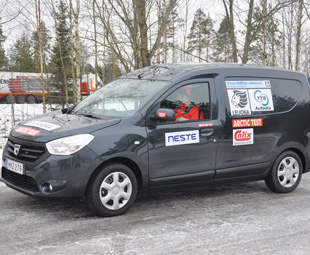 The Dacia Dokker surprised many in the test, in a positive way. Despite being the cheapest vehicle there, it is still very functional. Besides having the lowest price, the Dokker was also the most fuel-efficient. Its engine received praise for its flexibility and high torque levels. The group also liked the simple design of the cabin with its easy-to-use functions – even for those driving it for the first time.
The Dacia Dokker surprised many in the test, in a positive way. Despite being the cheapest vehicle there, it is still very functional. Besides having the lowest price, the Dokker was also the most fuel-efficient. Its engine received praise for its flexibility and high torque levels. The group also liked the simple design of the cabin with its easy-to-use functions – even for those driving it for the first time.
The Dacia’s heater got the best result in cold-start test. Unfortunately, it was not possible to test the heaters in really freezing temperatures.
The Romanian brand received low marks for its uncomfortable driver’s seat. Other critical comments related to noise inside the cabin, as well as from the side-mirrors and the wipers. The Dokker got least points in the handling test.
Test points 183
+ Cost-efficient
+ Simple design
+ Engine
– Seats
– Handling on slick road
– Visibility
Opel Combo Van 1.3 CDTI L2H1
Strongest carrier
 The Opel Combo had the most spacious cargo area. With 1 175 kg load capacity it has over 400 kg more payload than the next van on the list, making it the most suitable for moving heavier objects.
The Opel Combo had the most spacious cargo area. With 1 175 kg load capacity it has over 400 kg more payload than the next van on the list, making it the most suitable for moving heavier objects.
As they are essentially the same vehicle, both the Combo and the Doblo’s side mirrors were noted as exceptional. Their two-piece side mirrors are large and are proper commercial vehicle mirrors. While the wing mirrors provide good rear visibility, the A-pillar blocks the forward view a little, especially to the front-left on these left-hand-drive vehicles.
The Combo, which has the smallest engine, got the thumbs down for on-road performance and its lack of torque in the city. That said, its fuel economy was noted. Its gear ratios in the city were also seen as the weakest. Besides that, Opel’s start-stop system excelled in the city.
Test points 186
+ Heaviest load capacity
+ Mirrors
+ Doors
– Gear-ratios in the city
– Torque in the city
– Visibility
Renault Kangoo Express Maxi 1.5 dCi 90
Best cargo space
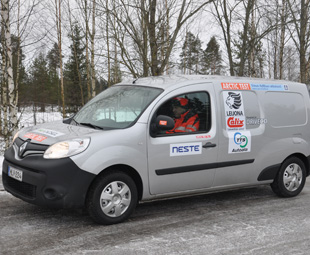 The current Renault Kangoo received best points for its cargo space and received merits for its durable surface and numerous load-securing hooks.
The current Renault Kangoo received best points for its cargo space and received merits for its durable surface and numerous load-securing hooks.
On the negative side, it scored poorly for its side-door loading access, which is exceptionally narrow because of the shape of the dividing wall.
Storage places around the cabin and the simplicity of van’s interior were ticked as good by test drivers, as was the quality of the materials used. The driver’s seat was noted as comfortable.
The Kangoo proved reliable in the drivability tests, with the suspension settings and especially the engine power-to-weight ratio receiving positive remarks. All over visibility was excellent, particularly in the reversing module. However, the Kangoo’s side mirrors are small.
Test points 187
+ Suspension
+ Cargo space
+ Visibility
– Mirrors
– Side door
– Adjustment buttons on the radio
Volkswagen Caddy 2.0 TDI BlueMotion Launch Edition
All-round Champion
 The test group really enjoyed the Euro-6 engine in the new fourth-generation Volkswagen Caddy. Having the highest displacement in the competition might explain the positive reception, and points to why Caddy4 received the best points in drivability, both in the city and out on the open roads.
The test group really enjoyed the Euro-6 engine in the new fourth-generation Volkswagen Caddy. Having the highest displacement in the competition might explain the positive reception, and points to why Caddy4 received the best points in drivability, both in the city and out on the open roads.
Top points were also given to the driver’s seat, which was evaluated as the most comfortable and for the cabin in general. The Caddy 4’s steerability was also rated highly by the panel, as were its smooth clutch and gearbox shifting and its strong brakes.
The Caddy was criticised for its visibility and side mirrors and its interior space wasn’t top of the list either.
By scoring most points all round, the Volkswagen Caddy4 was elected overall winner of Artic Van Test 2016.
Test points 188
+ Engine
+ Drivability
+ Ergonomics
– Visibility on side windows
– Traction control system
– Little room for folders, etc
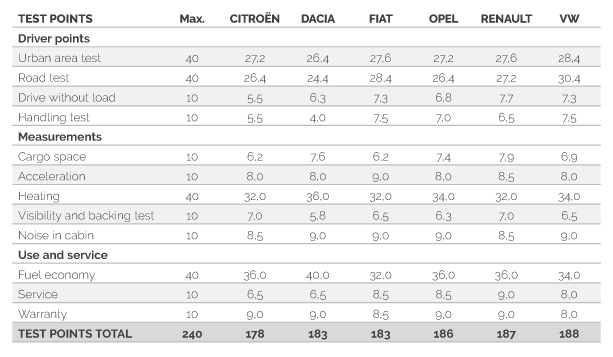
As regular readers of FOCUS know, this magazine has been appointed an associate member of the International Truck of the Year (IToY)! FOCUS is the sole South African magazine to have joined this prestigious body. One of the advantages of this association is access to exclusive articles, specially written for FOCUS by ITOY jury members. This is one such article
Published by
Focus on Transport
focusmagsa




